Figure 2. Human SMPX promoter activity is regulated by NOR-1.
(a) Scheme showing the four putative NBRE elements present in the SMPX promoter region cloned into the pGL3 reporter vector (pGL3/SMPX-2260). The consensus NBRE sequence (NBRE c.s.) is indicated and non-conserved bases are shown in bold. (b) Luciferase activity from cells co-transfected with a NOR-1 expression vector (pCMV5/NOR-1; black bars) or the corresponding empty plasmid (pCMV5; white bars) together with different pGL3/SMPX constructs. The activity of constructs mutated in the NBRE site (deleted white circle) is also shown. The core of the NBRE(−167/−160) is indicated and changes introduced by mutagenesis on constructs are boxed (n = 6). *P < 0.0001 vs. cells co-transfected with pCMV5; #P < 0.0001 vs. cells co-transfected with pCMV5/NOR-1 and SMPX constructs containing the native NBRE(−167/−160) site. (c) Representative autoradiograms of EMSA performed with a SMPX probe containing the NBRE(−167/−160) site (NBRE) and nuclear protein extracts from VSMC transduced with lentiviral vectors to express NOR-1-FLAG (pNOR-1F) or EGFP (pGFP). The position of the complexes up-regulated by NOR-1 (I and II) is indicated. Competition assays with a molar excess of unlabeled probe (100-fold; Competitor) and supershift assays with a specific antibody against the FLAG sequence (anti-FLAG Ab) were performed. EMSA carried out with a mutated NBRE probe (mut-NBRE) is also shown. SS: supershifted complex. (d) The relative in vivo association of NOR-1 with SMPX promoter was analyzed by ChIP assays in VSMC transduced with pGFP or pNOR-1F. Immunoprecipitations were performed with an antibody against the FLAG sequence (IP:FLAG) or a non-specific IgG (IP:IgG). The bars graph shows the enrichment of NOR-1 binding quantified by real-time PCR using SMPX promoter specific primers. Data were normalized to the total input DNA (n = 4). *P = 0.0002 vs. pGFP. The panel on right shows the agarose gel electrophoresis of PCR products. Equal input DNA and control IgG immunoprecipitations are shown.

